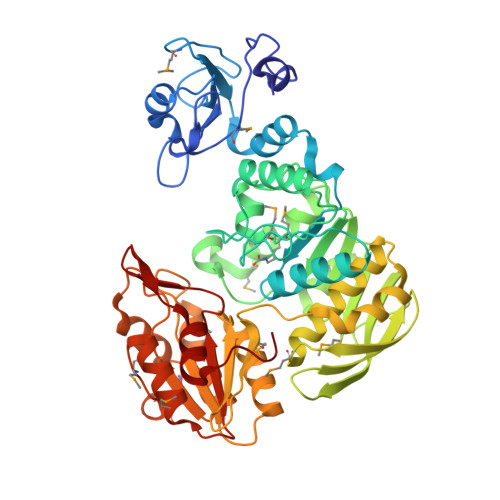Crystal Structure of Udp-N-Acetylmuramoyl-L-Alanyl-D-Glutamate: Meso-Diaminopimelate Ligase from Escherichia Coli
Gordon, E.J., Flouret, B., Chantalat, L., Van Heijenoort, J., Mengin-Lecreulx, D., Dideberg, O.(2001) J Biological Chem 276: 10999
- PubMed: 11124264
- DOI: https://doi.org/10.1074/jbc.M009835200
- Primary Citation of Related Structures:
1E8C - PubMed Abstract:
UDP-N-acetylmuramoyl-l-alanyl-d-glutamate:meso-diaminopimelate ligase is a cytoplasmic enzyme that catalyzes the addition of meso-diaminopimelic acid to nucleotide precursor UDP-N-acetylmuramoyl-l-alanyl-d-glutamate in the biosynthesis of bacterial cell-wall peptidoglycan. The crystal structure of the Escherichia coli enzyme in the presence of the final product of the enzymatic reaction, UDP-MurNAc-l-Ala-gamma-d-Glu-meso-A(2)pm, has been solved to 2.0 A resolution. Phase information was obtained by multiwavelength anomalous dispersion using the K shell edge of selenium. The protein consists of three domains, two of which have a topology reminiscent of the equivalent domain found in the already established three-dimensional structure of the UDP-N-acetylmuramoyl-l-alanine: D-glutamate-ligase (MurD) ligase, which catalyzes the immediate previous step of incorporation of d-glutamic acid in the biosynthesis of the peptidoglycan precursor. The refined model reveals the binding site for UDP-MurNAc-l-Ala-gamma-d-Glu-meso-A(2)pm, and comparison with the six known MurD structures allowed the identification of residues involved in the enzymatic mechanism. Interestingly, during refinement, an excess of electron density was observed, leading to the conclusion that, as in MurD, a carbamylated lysine residue is present in the active site. In addition, the structural determinant responsible for the selection of the amino acid to be added to the nucleotide precursor was identified.
- Institut de Biologie Structurale Jean-Pierre Ebel, CEA-CNRS, Laboratoire de Cristallographie Macromoléculaire, 41 rue Jules Horowitz, F-38027 Grenoble Cedex 1, France.
Organizational Affiliation:





















